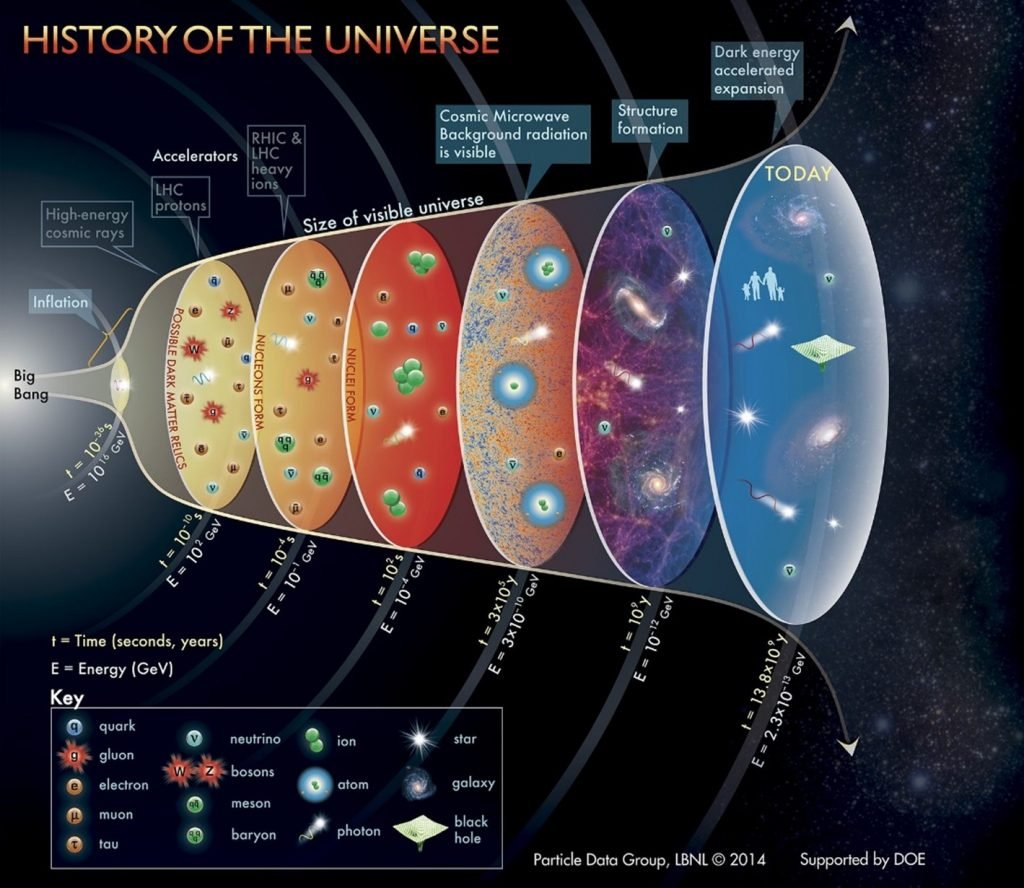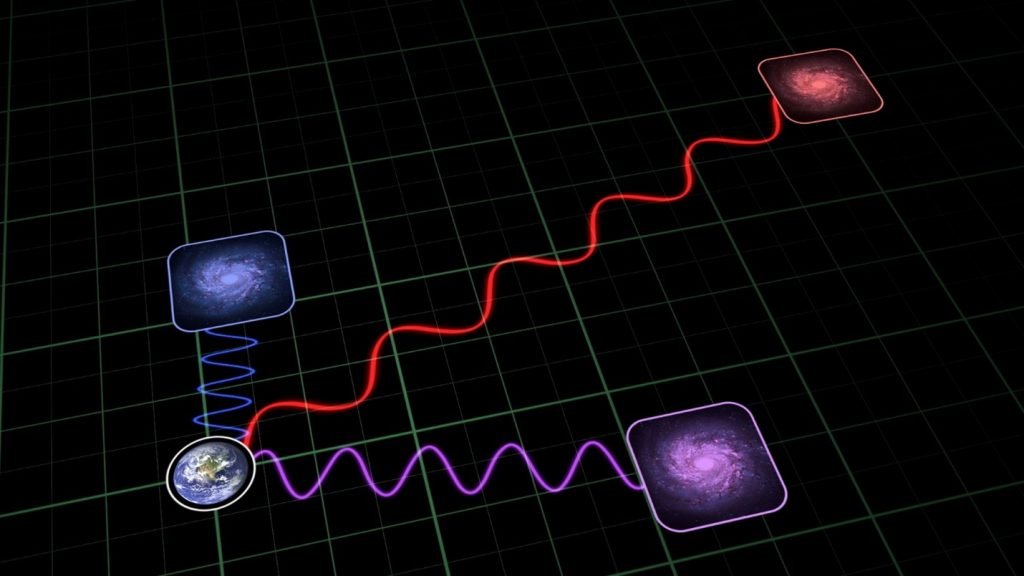Special welcome gift! Get 30% off on your first purchase. Use Code: EKA24P
Cosmology: Study of The Nature of The Universe
Evolution of Universe: Big Bang Theory
Big bang is a cosmological theory which explains the origin of the universe. According to this theory the universe was once compressed into extremely small volume which about 14.2 billion years ago exploded and began expanding rapidly. This rapid expansion caused the universe to cool and resulted in its present continuously expanding state.

Red shift
This phenomenon was first observed by Edwin Hubble.
As an object moves away from us light waves emitted by the object are stretched out and shift towards lower frequencies that is towards the red end of the electromagnetic spectrum where light has longer wavelength. Red shift indicates that all galaxies are moving away from each other.

Blue Shift
It happens when distant objects are coming closer to observer causing shortening of wavelength.
See Animation on Red shift and Blue Shift (Source: NASA): Link 1 | Link 2 | Link 3Cosmic Microwave Background Radiation (CMB)
It is a faint glow of light that fills the universe in every direction with nearly uniform intensity.
It is left over from the Big Bang and its presence is a proof of Big Bang Theory.
According to CMB observation, most of universe is made up of dark energy which is driving the expansion of universe and dark matter which interacts with rest of universe through its gravity.
WMAP data of the Cosmic Microwave Background. Credit: NASA
Galaxy
Galaxy is a gravitationally bound system of stars, planets, rocks, dust, interstellar gas, and dark matter.
Galaxy starts to form by accumulation of hydrogen gas in the form of a very large cloud called nebula.
Three main shapes of galaxies are: elliptical, spiral, and irregular.
Our sun belongs to Milky Way Galaxy (Spiral Galaxy with bar shaped core) which itself belongs to a cluster of 30 galaxies called Local Group.
Supercluster
It is a group of smaller Galaxy clusters or Galaxy groups. It is among the largest known clusters of cosmos.
Recently Indian scientists discovered a supercluster and named it Saraswati which is about 4 billion light years away from earth.
Our Milky Way is itself a part of Laniakea supercluster.
Nebula
Nebula is an enormous cloud of interstellar dust and hydrogen gas which acts as a building block of stars, galaxies and planets.
In this image of the Carina Nebula, you can spot tiny yellow and white dots inside pink dust clouds. Those tiny dots are newly-formed stars! Credit NASA/JPL-Caltech/University of Colorado
Types of nebula
- Emission nebulae: These are clouds of high temperature gas. In these atoms get excited by absorbing ultraviolet rays from nearby stars and emit radiation as they fall back to low energy states. They are usually red in colour.
- Reflection nebulae: These are cloud of dusts which simply reflect the light of nearby stars.
- Dark nebulae: They blocks light and looks like dark patches against brighter region of space. They are physically similar to reflection nebulae but look different because of geometry of light source, cloud and earth.
- Planetary nebulae: These are shells of gas thrown out by some stars near the end of their lives. They have nothing to do with planets. They are so called because they appears like planets when seen from small telescopes.
- Supernova remnants: it is a structure which results from the explosion of supernova. The supernova remnant is bounded by expanding shock waves, and consists of ejected material expanding from the explosion, and the interstellar material it sweeps up and shocks along the way. Supernova remnants are extremely important as their major source of heating of interstellar gas through shocks and magnetic turbulence and also source of heavy elements from oxygen onwards.
Astronomers use very powerful telescopes to take pictures of faraway nebulae. Space telescopes such as NASA’s Spitzer Space Telescope and Hubble Space Telescope have captured many images of faraway nebulae.
Nebulae exist in the space between the stars—also known as interstellar space.
The closest known nebula to Earth is called the Helix Nebula. It is the remnant of a dying star—possibly one like the Sun. It is approximately 700 light-years away from Earth. That means even if you could travel at the speed of light, it would still take you 700 years to get there!
Star
Stars are balls of gases mostly hydrogen and helium which produces light and heat from the churning of nuclear forces within their core.
A star is formed when turbulence deep within the dust clouds give rise to not with sufficient mass that causes the gas and dust to collapse under its own gravitational attraction.
As cloud collapses the material at the centre begins to heat up and nuclear fusion reaction starts. This stage is known as protostar, and it paves way for different stages for star formation.
Types of stars
- Red dwarfs: They are smaller than sun and live a long time as they burn slowly.
- Blue giants: They are among hottest stars and live for less than 100 years.
- Supergiant: These are rarest of stars which have life less than 50 million years.
- Neutron star: It is a body of densely packed neutrons formed after explosion of supernova. Neutron star is one of the possible ends of a star during its life cycle. Due to its high density, a neutron star being around 20 kilometre in diameter is about 1.4 times mass of our sun and its magnetic field is million times stronger done that of our earth.
Life cycle of stars
Stars come in a variety of masses and the mass determines how radiantly the star will shine and how it dies. Massive stars transform into supernovae, neutron stars and black holes while average stars like the sun, end life as a white dwarf surrounded by a disappearing planetary nebula. All stars, irrespective of their size, follow the same 7 stage cycle, they start as a gas cloud and end as a star remnant.
Diagram showing the lifecycles of Sun-like and massive stars. Click image for larger version. (Credit: NASA and the Night Sky Network)
1. Giant Gas Cloud
A star originates from a large cloud of gas. The temperature in the cloud is low enough for the synthesis of molecules. The Orion cloud complex in the Orion system is an example of a star in this stage of life.
2. Protostar
When the gas particles in the molecular cloud run into each other, heat energy is produced. This results in the formation of a warm clump of molecules referred to as the Protostar. The creation of Protostars can be seen through infrared vision as the Protostars are warmer than other materials in the molecular cloud. Several Protostars can be formed in one cloud, depending on the size of the molecular cloud.
3. T-Tauri Phase
A T-Tauri star begins when materials stop falling into the Protostar and release tremendous amounts of energy. The mean temperature of the Tauri star isn’t enough to support nuclear fusion at its core. The T-Tauri star lasts for about 100 million years, following which it enters the most extended phase of development – the Main sequence phase.
4. Main Sequence
The main sequence phase is the stage in development where the core temperature reaches the point for the fusion to commence. In this process, the protons of hydrogen are converted into atoms of helium. This reaction is exothermic; it gives off more heat than it requires and so the core of a main-sequence star releases a tremendous amount of energy.
5. Red Giant
A star converts hydrogen atoms into helium over its course of life at its core. Eventually, the hydrogen fuel runs out, and the internal reaction stops. Without the reactions occurring at the core, a star contracts inward through gravity causing it to expand. As it expands, the star first becomes a subgiant star and then a red giant. Red giants have cooler surfaces than the main-sequence star, and because of this, they appear red than yellow.
6. The Fusion of Heavier Elements
Helium molecules fuse at the core, as the star expands. The energy of this reaction prevents the core from collapsing. The core shrinks and begins fusing carbon, once the helium fusion ends. This process repeats until iron appears at the core. The iron fusion reaction absorbs energy, which causes the core to collapse. This implosion transforms massive stars into a supernova while smaller stars like the sun contract into white dwarfs.
7. Supernovae and Planetary Nebulae
Most of the star material is blasted away into space, but the core implodes into a neutron star or a singularity known as the black hole. Less massive stars don’t explode, their cores contract instead into a tiny, hot star known as the white dwarf while the outer material drifts away. Stars tinier than the sun, don’t have enough mass to burn with anything but a red glow during their main sequence. These red dwarves are difficult to spot. But, these may be the most common stars that can burn for trillions of years.
The above were the seven main stages of the life cycle of a star. Whether big or small, young or old, stars are one of the most beautiful and lyrical objects in all of creation. Next time you look up at the stars, remember, this is how they were created and how they will die.
